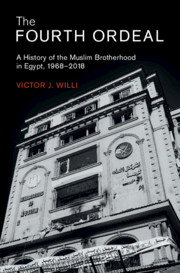Book contents
- The Fourth Ordeal
- Cambridge Middle East Studies
- The Fourth Ordeal
- Copyright page
- Dedication
- Contents
- Plates, Figures and Tables
- Acknowledgements
- Note on Transliterations and References
- Note on Sources
- Chronology of Events
- Dramatis Personae
- Abbreviations
- Prologue
- Introduction
- 1 The Society of the Muslim Brothers
- 2 The Second Founding (1968–1981)
- 3 The Rise of the Vanguard (1981–1991)
- 4 Brotherhood Incorporated (1991–2001)
- 5 Struggle for Leadership (2001–2011)
- 6 Revolution, Rise and Fall (2011–2013)
- 7 The Beginning of the Fourth Ordeal (2013–2018)
- Conclusion
- Epilogue
- Glossary
- Bibliography
- Index
- Books in the Series
- Plate Section
- Plate Section
5 - Struggle for Leadership (2001–2011)
Published online by Cambridge University Press: 02 February 2021
- The Fourth Ordeal
- Cambridge Middle East Studies
- The Fourth Ordeal
- Copyright page
- Dedication
- Contents
- Plates, Figures and Tables
- Acknowledgements
- Note on Transliterations and References
- Note on Sources
- Chronology of Events
- Dramatis Personae
- Abbreviations
- Prologue
- Introduction
- 1 The Society of the Muslim Brothers
- 2 The Second Founding (1968–1981)
- 3 The Rise of the Vanguard (1981–1991)
- 4 Brotherhood Incorporated (1991–2001)
- 5 Struggle for Leadership (2001–2011)
- 6 Revolution, Rise and Fall (2011–2013)
- 7 The Beginning of the Fourth Ordeal (2013–2018)
- Conclusion
- Epilogue
- Glossary
- Bibliography
- Index
- Books in the Series
- Plate Section
- Plate Section
Summary
This chapter looks at the Brotherhood’s evolution in the decade after 9/11, and how debates about principles gradually morphed into an identity crisis concerning the organization as a whole. Against the setting of an unstable global security environment, marked first by a US-led ‘global war on terror’ and then by US-sponsored projects for the ‘democratization’ of the Middle East, the chapter highlights the debates between the followers of the Tilmisani school on the one hand, and the vanguardist faction on the other. The chapter also introduces the youth members of the Muslim Brotherhood who, in the context of an increasingly potent social protest movement, found themselves increasingly at odds with their leadership. The chapter ends with the contentious Guidance Office elections of the winter of 2009, when the vanguard leaders asserted total control of the Brotherhood’s executive office. Based on Oral History interviews with key Brotherhood members from across all organizational ranks, memoires and available online material, original texts published by the Brotherhood, an analysis of the Brotherhood-related diplomatic correspondence of the US Embassy in Cairo as published by Wikileaks, and a reading of the available scholarly literature, the chapter recounts how the Muslim Brotherhood, while meandering through an unstable global security environment, became further entrenched within its own internal bickering and squabbles to yield a weakened organization unready to meet the challenges of the Egyptian uprising of 2011.
Keywords
- Type
- Chapter
- Information
- The Fourth OrdealA History of the Muslim Brotherhood in Egypt, 1968–2018, pp. 179 - 229Publisher: Cambridge University PressPrint publication year: 2021

